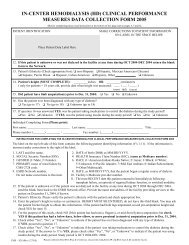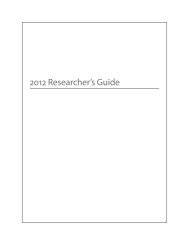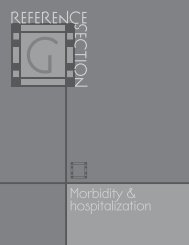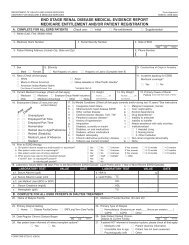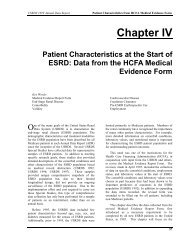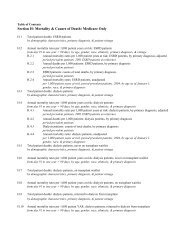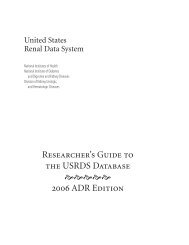2009 ADR v2 Atlas of ESRD - United States Renal Data System
2009 ADR v2 Atlas of ESRD - United States Renal Data System
2009 ADR v2 Atlas of ESRD - United States Renal Data System
You also want an ePaper? Increase the reach of your titles
YUMPU automatically turns print PDFs into web optimized ePapers that Google loves.
5<br />
App A<br />
pg 368<br />
for Figure p.17 in the Précis. Principal ICD-9-CM diagnosis codes<br />
are used to identify cardiovascular and infectious admissions. The<br />
cardiovascular category consists <strong>of</strong> codes 276.6, 394–398.99, 401–405,<br />
410–420, 421.9, 422.90, 422.99, 423–438, and 440–459, while infection<br />
is indicated by codes 001–139, 254.1, 320–326, 331.81, 372–372.39, 373.0–<br />
373.2, 382–382.4, 383.0, 386.33, 386.35, 388.60, 390–393, 421–421.1, 422.0,<br />
422.91–422.93, 460–466, 472–474.0, 475–476.1, 478.21–478.24, 478.29,<br />
480–490, 491.1, 494, 510–511, 513.0, 518.6, 519.01, 522.5, 522.7, 527.3, 528.3,<br />
540–542, 566–567.9, 569.5, 572–572.1, 573.1–573.3, 575–575.12, 590–590.9,<br />
595–595.4, 597–597.89, 598, 599.0, 601–601.9, 604–604.9, 607.1, 607.2,<br />
608.0, 608.4, 611.0, 614–616.1, 616.3–616.4, 616.8, 670, 680–686.9, 706.0,<br />
711–711.9, 730–730.3, 730.8–730.9, 790.7–790.8, 996.60–996.69, 997.62,<br />
998.5, and 999.3. Figure 6.3 presents adjusted rates <strong>of</strong> total hospital<br />
admissions and days per patient year. Prevalent <strong>ESRD</strong> patients are<br />
included, and rates are adjusted for age, gender, race, & primary<br />
diagnosis with the 2005 <strong>ESRD</strong> cohort used as the reference.<br />
Figure 6.4 shows adjusted admission rates for principal diagnoses<br />
for prevalent <strong>ESRD</strong> patients. Again, rates are adjusted for age, gender,<br />
race, and primary diagnosis, with <strong>ESRD</strong> patients in 2005 used as the<br />
reference cohort. Principal ICD-9-CM codes are as follows: pneumonia,<br />
480–486 and 487.0; bacteremia/septicemia, 038.0–038.9 and<br />
790.7; cellulitis, 682; vascular access infection (hemodialysis patients<br />
only), 996.62; and peritonitis (peritoneal dialysis patients only), 567.<br />
Table 6.a presents adjusted admission rates and relative risks <strong>of</strong><br />
admission among adult (age 20 and older) period prevalent hemodialysis<br />
patients. Principal ICD-9-CM diagnosis codes are used to<br />
identify cardiovascular and infectious admissions, and are listed in<br />
the discussion <strong>of</strong> Figure 6.2. Vascular access admissions are defined<br />
as “pure” inpatient vascular access events, as described for vascular/<br />
dialysis access events in Tables G.11–15; vascular access, however,<br />
excludes the codes specific to peritoneal dialysis catheters (996.56,<br />
996.68, and V56.2). Rates and relative risks are adjusted for age,<br />
gender, race, and primary <strong>ESRD</strong> diagnosis, while values presented<br />
by one factor are adjusted for the other three. Adjusted relative<br />
risks are calculated with a Poisson model, with reference groups<br />
as listed. For adjusted rates, hemodialysis patients in 2005 are used<br />
as the reference cohort. Values by age, gender, race, and primary<br />
diagnosis are shown for 2006–2007 prevalent hemodialysis patients.<br />
Figures 6.9–11 show rates by age, adjusted for gender, race, and<br />
primary diagnosis, using the model-based adjustment method. They<br />
include period prevalent dialysis (Figures 6.9–10) and hemodialysis<br />
(Figure 6.11) patients age 20 and older, with the 2005 dialysis cohort<br />
as the reference. Figure 6.9 presents adjusted rates <strong>of</strong> cause-specific<br />
hospital admissions per patient year. The categories for cardiovascular<br />
disease and infection are defined by the codes listed for Figure<br />
6.2; the infection codes for Figure 6.9 exclude those due to an internal<br />
device. The principal ICD-9-CM diagnosis codes used for infection<br />
due to internal device (related to a vascular access device or peritoneal<br />
dialysis catheter) are 996.62 and 996.68. At the end <strong>of</strong> 1998 a<br />
new ICD-9-CM code was added for infections due to internal devices<br />
in peritoneal dialysis patients; data prior to this date are omitted.<br />
Figure 6.10 shows adjusted event rates for inpatient coronary<br />
revascularization. Patients are followed until the first coronary<br />
revascularization event, and are censored at the earliest <strong>of</strong> death,<br />
three days prior to transplant, or the end <strong>of</strong> the calendar year. Events<br />
are identified from inpatient and physician/supplier claims occurring<br />
within a hospital stay. The following ICD-9-CM procedure and<br />
CPT codes are used to identify events: angioplasty, procedure codes<br />
00.66, 36.01, 36.02, and 36.05, and CPT codes 92982, 92984, 92995,<br />
and 92996; coronary stents, procedure code 36.06 and CPT codes<br />
92980–92981; and bypass, procedure codes 36.1x and CPT codes<br />
33510–33523, 33533–33536. Rates for coronary stents are shown starting<br />
in 1997, due to the release <strong>of</strong> CPT codes.<br />
Figure 6.11 displays adjusted vascular access placement rates for<br />
period prevalent adult hemodialysis patients. These are not hospital<br />
admission rates, but procedure rates for vascular access placements<br />
in an inpatient setting. Vascular access placements are obtained<br />
from CPT codes on physician/supplier claims, and are restricted to<br />
those occurring in the hospital (during an inpatient stay or emergency<br />
room visit). Categories include catheters, fistulas, and grafts,<br />
and the CPT codes used to define them are found in Table a.b later<br />
in this appendix. The category for all vascular access placements<br />
includes the CPT codes for all <strong>of</strong> the above categories. Methods are<br />
also used to exclude vascular access used for purposes other than<br />
dialysis. Catheter placement codes that are not specific for dialysis<br />
are included only if they are accompanied by an ICD-9-CM renal<br />
diagnosis code. Also, rates for catheter and all vascular access placements<br />
exclude patients with specific chemotherapy or parenteral<br />
nutrition claims during the year. Inpatient/outpatient institutional,<br />
physician/supplier, and durable medical equipment claims indicate<br />
chemotherapy (CPT codes 96408, 96410, and 96412) or parenteral<br />
nutrition (CPT codes B4164–B5200, B9004, B9006, and B9999).<br />
MORTALITY<br />
Patient cohorts for all mortality figures here include both Medicare<br />
and non–Medicare patients living in the 50 states, the District <strong>of</strong><br />
Columbia, Puerto Rico, and the Territories.<br />
Figure 6.1 shows trends in mortality rates by modality for incident<br />
<strong>ESRD</strong> patients, 1980–2006. The population groups include all-<strong>ESRD</strong>,<br />
hemodialysis, CAPD/CCPD, and first transplant (known deceased<br />
and living donors only). Adjusted first-, second-, third-, fourth-,<br />
and fifth-year mortality rates for incident cohorts — including all-<br />
<strong>ESRD</strong>, hemodialysis, CAPD/CCPD, and first transplant patients — are<br />
computed from the Cox model using the model-based adjustment<br />
method, described later in this appendix. Mortality rates for all<br />
patients are adjusted for age, gender, race, and primary diagnosis.<br />
The reference population for adjusted rates consists <strong>of</strong> 2005 incident<br />
<strong>ESRD</strong> patients.<br />
Figure 6.5 presents unadjusted all-cause mortality, by HSA, for<br />
2007 prevalent <strong>ESRD</strong>, dialysis, transplant, and general Medicare<br />
patients age 65 and older. General Medicare patients are non-<strong>ESRD</strong><br />
patients with at least one month <strong>of</strong> Medicare eligibility in 2007;<br />
they are followed from the first day <strong>of</strong> the first month with Medicare<br />
eligibility until death or December 31, 2007. <strong>ESRD</strong> patients are<br />
followed from January 1 until December 31, 2007.<br />
Table 6.b shows expected remaining lifetimes for dialysis patients,<br />
renal transplant patients, and the general U.S. population in 2004.<br />
For period prevalent <strong>ESRD</strong> patients in 2007, expected lifetimes are<br />
calculated using the death rates from the mixed model with 16 age<br />
groups, assuming constant survival and mortality within each age<br />
group. Patient inclusion and exclusion criteria are those used in<br />
Tables H.4.4 and H.28.4, and the method for calculating expected<br />
remaining lifetimes is described in the section on statistical methods<br />
at the end <strong>of</strong> this appendix. <strong>Data</strong> for the general population are<br />
obtained from the CDC’s National Vital Statistics Reports.<br />
Figure 6.6 shows all-cause mortality by age for 2007 prevalent<br />
<strong>ESRD</strong>, dialysis, transplant, and general Medicare patients. All-cause<br />
mortality rates by age are calculated using generalized mixed models,<br />
and are adjusted for gender and race. Medicare patients from<br />
2007 are used as the reference cohort.<br />
Figure 6.7 illustrates trends in mortality rates by patient vintage<br />
for period prevalent dialysis patients alive on renal replacement




